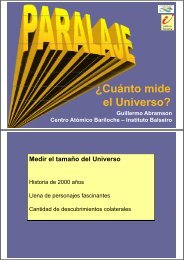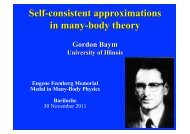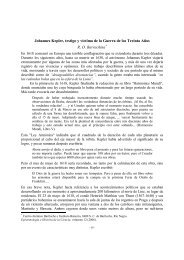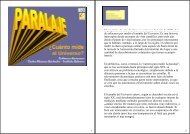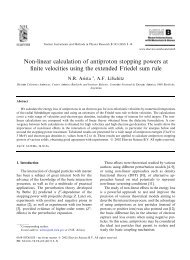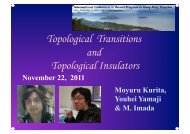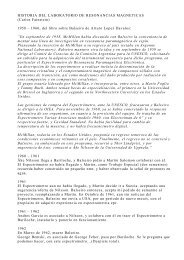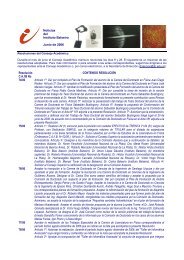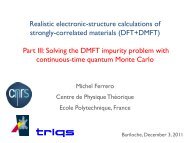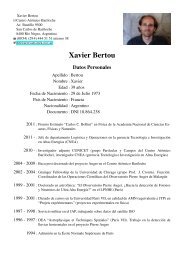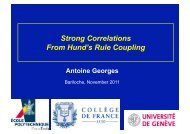t f<strong>in</strong>ite temperature where <strong>the</strong> correlation funcder-parameterphase. Never<strong>the</strong>less e ı changes a from phaseexponential transitiontoPr<strong>in</strong>cipal Steps:temperature where <strong>the</strong> correlation funcarametere ı changes from exponential totransition. The quantum dissipative generalizatiomodel <strong>in</strong>cludes two dynamical terms and is given bpower law. This is <strong>the</strong> Kosterlitz-Thoulesstransition. 25,26 The quantum dissipative generalizmodel <strong>in</strong>cludes two dynamical terms and is giveZ = D i exp − 0= Z D i exp − 0S diss =−d0did ij,klC2 2 ij − J cos ij − klij,kl ij − kl ij,kl − ij − kl − + S diss ,e capacitance andS=R Q /R, where R Q =h/4e 2 .cs of this phase transition diss d ,=−isd0better understoodij,kl<strong>in</strong> terms of <strong>the</strong> − topological defects of <strong>the</strong> system. To dndard procedure of us<strong>in</strong>g <strong>the</strong> Villa<strong>in</strong> transform and <strong>in</strong>tegrat<strong>in</strong>g out <strong>the</strong> phase degrees of freedom. 20 Thacitance olves expand<strong>in</strong>g Villa<strong>in</strong> =R Transformation:<strong>the</strong> Q periodic /R, where function R Q =h/4e <strong>in</strong> terms 2 . of a periodic Gaussianthis phase transitionexp − J is better understood 1 − cos ij − kl <strong>in</strong> termsij,klm ij;klexp − of J <strong>the</strong> topological defects of ij − kl − 2m ij;kl /2 2 ,<strong>the</strong> system. Tprocedure of us<strong>in</strong>g <strong>the</strong> Villa<strong>in</strong> transform and <strong>in</strong>tegrat<strong>in</strong>g out <strong>the</strong> phase degrees of freedom. 20ij,klre <strong>in</strong>tegers that live on <strong>the</strong> l<strong>in</strong>ks of <strong>the</strong> orig<strong>in</strong>al. We can comb<strong>in</strong>e <strong>the</strong> two l<strong>in</strong>k variables m i,j;i+1,jto one <strong>in</strong>tegrated two-component over. vector m i,j that lives onof <strong>the</strong> lattice see Fig. 1. We expand <strong>the</strong> quadtransform to Fourier space. Keep<strong>in</strong>g <strong>the</strong> lead-diC2 2 ij − J cos ij − kl xy − x+1,y − 2m xx,y+ S diss ,2 ij − kl − ij − kl 2expand<strong>in</strong>g <strong>the</strong> periodic function <strong>in</strong> terms of a periodic Gaussianexp − J ij,kl1 − cos ij − kl m ij;klexp − J ij − kl − 2m ij;kl /2 2 ,ij,klNow <strong>the</strong> model is Gaussian <strong>in</strong> <strong>the</strong>θ’swhich can be, 2 a 2 2 xx xy +4a x xy m x,yxwhere m x,y is <strong>the</strong> x component of <strong>the</strong> vector field<strong>the</strong> <strong>in</strong>teger m . In <strong>the</strong> absence of dissipation,egers that live on <strong>the</strong> l<strong>in</strong>ks of <strong>the</strong> orig<strong>in</strong>al − − 2m x 2 a 2 2 +4a m x+
2 2where m x,y is <strong>the</strong> x component of <strong>the</strong><strong>the</strong> <strong>in</strong>teger m x,y;x+1,y . In <strong>the</strong> absence ofcompetition between <strong>the</strong> k<strong>in</strong>etic-energenergy terms, <strong>the</strong> former m<strong>in</strong>imized bydisordered stabiliz<strong>in</strong>g an <strong>in</strong>sulat<strong>in</strong>g phm<strong>in</strong>imized by a fixed value of ij staductor. S<strong>in</strong>ce ’s are bosonic degrees ofimpose <strong>the</strong> boundary condition that ij odicity <strong>in</strong> <strong>the</strong> imag<strong>in</strong>ary-time directionof <strong>the</strong> field ij implies that <strong>the</strong>re is anfreedom that has to be accounted for wnumber. At T=0, <strong>the</strong> imag<strong>in</strong>ary- tim<strong>in</strong>f<strong>in</strong>ite <strong>in</strong> extent, and <strong>the</strong> nondissipatthree-dimensional 3D XY universalitycretize <strong>the</strong> imag<strong>in</strong>ary-time direction <strong>in</strong>on a three-dimensional lattice. Introduwhich only live on <strong>the</strong> spatial l<strong>in</strong>ks, <strong>the</strong>disordered stabiliz<strong>in</strong>g and m i,j;ij+1 <strong>in</strong>to onean two-component <strong>in</strong>sulat<strong>in</strong>g vector m i,j phase that lives on while <strong>the</strong> latter<strong>the</strong> site i, j of <strong>the</strong> lattice see Fig. 1. We expand <strong>the</strong> quadraticatermfixed and transform value to Fourier ofspace. Keep<strong>in</strong>g <strong>the</strong> lead-xm<strong>in</strong>imized by<strong>in</strong>g quadratic term i,j − i+1,j −a x xy , where ij stabiliz<strong>in</strong>g a superconductor.m is S<strong>in</strong>ce a discretea is <strong>the</strong> latticeconstant, ’s are x=ai<strong>in</strong>teger bosonic and y=aj, we getfield degrees which of freedom, lives on we l<strong>in</strong>ks. need toimpose <strong>the</strong> boundary condition that ij = ij 0. The periodicity<strong>in</strong> <strong>the</strong> imag<strong>in</strong>ary-time i, j+y direction and <strong>the</strong> compactnessof <strong>the</strong> field ij implies that <strong>the</strong>re is an additional degree ofm i,j;i,j+ym mfreedom that has to bei-x,accountedj; i, ji, j; i+x, jfor which is <strong>the</strong> w<strong>in</strong>d<strong>in</strong>gi-x, ji, j i+x, jnumber. At T=0, <strong>the</strong> imag<strong>in</strong>ary- time direction becomesm i ,j-y; i, j<strong>in</strong>f<strong>in</strong>ite <strong>in</strong> extent, and <strong>the</strong> nondissipative model is <strong>in</strong> <strong>the</strong>three-dimensional 3D XY i-x, j-y universality class. First we discretize<strong>the</strong> imag<strong>in</strong>ary-time direction <strong>in</strong> units of and workZ = exp(a)on a three-dimensional lattice. Introduc<strong>in</strong>g <strong>the</strong> variables m k, mwhich only live on <strong>the</strong> spatial l<strong>in</strong>ks, <strong>the</strong> action is 19,20After <strong>in</strong>tegrat<strong>in</strong>g over <strong>the</strong> sZ = mm i,j;i,j+yexpk,m i, j; i+x, j− 4 2 J(b)FIG. 1. Color onl<strong>in</strong>e The directed l<strong>in</strong>k variables are labeled asshown <strong>in</strong> <strong>the</strong> 2 a. b We def<strong>in</strong>e a two-component vector liv<strong>in</strong>g on<strong>the</strong> sites of <strong>the</strong>m orig<strong>in</strong>al · mC/c lattice whose + components k 2 /are <strong>the</strong> two directedl<strong>in</strong>ks variables: m=m i,j;i+x,j ,m i,j;i,j+x . n m ijJck m 2C/c n 2 + Jck 2 + n k 2− 4 2 J nC/c 2 n + Jck 2 + n k 2,174501-2− 4 2 JckJC/c 2 n +− 4 2 J 2 nm · mC/c + k 2 / nC/c 2 n + Jck 2 + n where c=a/, J→Ja 2 , C→Ca 2 /have also redef<strong>in</strong>ed →a 3 . The last tetor is unimportant and may be dropped.has two possible phase transitions, depecapacitance C or <strong>the</strong> dissipation term <strong>the</strong> second term <strong>in</strong> Eq. 5 dom<strong>in</strong>ates <strong>in</strong>low-frequency limit. The former correswith <strong>the</strong> dynamic critical z=1, i.e., we5



